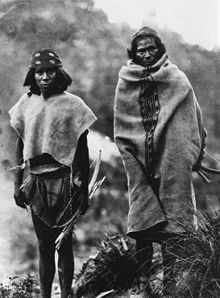Raramuri

Two Tarahumara men photographed in Tuaripa, Chihuahua, in 1892 by Carl Lumholtz
|
|
| Total population | |
|---|---|
| (Unknown: Estimates Vary) | |
| Regions with significant populations | |
| Mexico (Chihuahua, Durango, Sonora) | |
| Languages | |
| Rarámuri ra'ícha, Spanish | |
| Religion | |
| Animism, Peyotism, and Roman Catholic | |
| Related ethnic groups | |
| Suma, Guarijío, Huichol, Tepehuán, Mayo, Apache, Yaqui |
The Rarámuri or Tarahumara are a Native American people of northwestern Mexico who are renowned for their long-distance running ability. In their language, the term rarámuri refers specifically to the men, women are referred to as mukí (individually) and as omugí or igómale (collectively).
Originally inhabitants of much of the state of Chihuahua, the Rarámuri retreated to the high sierras and canyons such as the Copper Canyon in the Sierra Madre Occidental on the arrival of Spanish explorers in the 16th century. The area of the Sierra Madre Occidental which they now inhabit is often called the Sierra Tarahumara because of their presence.
Estimates put the population of the Rarámuri in 2006 at between 50,000 and 70,000 people. Most still practice a traditional lifestyle, inhabiting natural shelters such as caves or cliff overhangs, as well as small cabins of wood or stone. Staple crops are corn and beans; however, many of the Rarámuri still practice transhumance, raising cattle, sheep, and goats. Almost all Rarámuri migrate in some form or another in the course of the year.
The Tarahumara language belongs to the Uto-Aztecan family. Although it is in decline under pressure from Spanish, it is still widely spoken.
The Rarámuri are believed to be descended from a people of the Mogollon culture. The Rarámuri repulsed and were never conquered by the Spanish conquistadors or fully converted by the Jesuit missionaries. When the Spanish arrived in the 1500s, they called this native people the "Tarahumara". By the early 17th century, the Spanish had established mines in Tarahumara territory and made some slave raids to obtain workers for the mines. Jesuit Juan Fonte established a mission, San Pablo Balleza, at the southern end of Tarahumara territory, expanding from missionary work with the Tepehuan to the south. The Tepehuan's violent resistance to Spanish incursion in the Tepehuan revolt of 1616 killed Fonte and seven other Jesuit missionaries, closing the mission for over a decade.
...
Wikipedia
